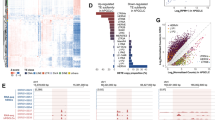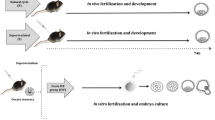Abstract
Purpose
Millions of pregnant, HIV-infected women take reverse transcriptase inhibitors, such as zidovudine (azidothymidine or AZT), during pregnancy. Reverse transcription plays important roles in early development, including regulation of telomere length (TL) and activity of transposable elements (TE). So we evaluated the effects of AZT on embryo development, TL, and copy number of an active TE, Long Interspersed Nuclear Element 1 (LINE-1), during early development in a murine model.
Design
Experimental study.
Methods
In vivo fertilized mouse zygotes from B6C3F1/B6D2F1 mice were cultured for 48 h in KSOM with no AZT (n = 45), AZT 1 μM (n = 46) or AZT 10 μM (n = 48). TL was measured by single-cell quantitative PCR (SC-pqPCR) and LINE-1 copy number by qPCR. The percentage of morulas at 48 h, TL and LINE-1 copy number were compared among groups.
Results
Exposure to AZT 1 μM or 10 μM significantly impairs early embryo development. TL elongates from oocyte to control embryos. TL in AZT 1 μM embryos is shorter than in control embryos. LINE-1 copy number is significantly lower in oocytes than control embryos. AZT 1 μM increases LINE-1 copy number compared to oocytes controls, and AZT 10 μM embryos.
Conclusion
AZT at concentrations approaching those used to prevent perinatal HIV transmission compromises mouse embryo development, prevents telomere elongation and increases LINE-1 copy number after 48 h treatment. The impact of these effects on the trajectory of aging of children exposed to AZT early during development deserves further investigation.


Similar content being viewed by others
Data availability
All authors declare data and material are available for consultation.
References
Fowler MG, Qin M, Fiscus SA, Currier JS, Flynn PM, Chipato T et al (2016) Benefits and risks of antiretroviral therapy for perinatal HIV prevention. N Engl J Med 375:1726–1737
W.H.O. Consolidated guidelines on the use of antiretroviral drugs for treating and preventing HIV infection. World Health Organization. 2016
Palm W, de Lange T (2008) How shelterin protects mammalian telomeres. Annu Rev Genet 42:301–334
Counter CM, Avilion AA, LeFeuvre CE, Stewart NG, Greider CW, Harley CB et al (1992) Telomere shortening associated with chromosome instability is arrested in immortal cells which express telomerase activity. EMBO J 11:1921–1929
Keefe DL (2016) Telomeres, reproductive aging, and genomic instability during early development. Reprod Sci 23:1612–1615
Liu L, Bailey SM, Okuka M, Muñoz P, Li C, Zhou L et al (2007) Telomere lengthening early in development. Nat Cell Biol 9:1436–1441
Gaspar TB, Sá A, Lopes JM, Sobrinho-Simões M, Soares P, Vinagre J (2018) Telomere maintenance mechanisms in cancer. Genes (Basel). 2018:9
Brouha B, Schustak J, Badge RM, Lutz-Prigge S, Farley AH, Moran JV et al (2003) Hot L1s account for the bulk of retrotransposition in the human population. Proc Natl Acad Sci USA 100:5280–5285
Spadafora C (2015) A LINE-1-encoded reverse transcriptase-dependent regulatory mechanism is active in embryogenesis and tumorigenesis. Ann N Y Acad Sci 1341:164–171
Beraldi R, Pittoggi C, Sciamanna I, Mattei E, Spadafora C (2006) Expression of LINE-1 retroposons is essential for murine preimplantation development. Mol Reprod Dev 73:279–287
Bondarev IE, Khavinson VK (2016) Suppression of alternative telomere lengthening in cancer cells with reverse transcriptase inhibitors. Adv Gerontol 29:218–221
Zijlmans JM, Martens UM, Poon SS, Raap AK, Tanke HJ, Ward RK et al (1997) Telomeres in the mouse have large inter-chromosomal variations in the number of T2AG3 repeats. Proc Natl Acad Sci USA 94:7423–7428
Muñoz-Lorente MA, Cano-Martin AC, Blasco MA (2019) Mice with hyper-long telomeres show less metabolic aging and longer lifespans. Nat Commun 10:4723
Shay JW, Wright WE (2005) Senescence and immortalization: role of telomeres and telomerase. Carcinogenesis 26:867–874
Gorbunova V, Seluanov A (2009) Coevolution of telomerase activity and body mass in mammals: from mice to beavers. Mech Ageing Dev 130:3–9
Cheng D, Wang S, Jia W, Zhao Y, Zhang F, Kang J et al (2017) Regulation of human and mouse telomerase genes by genomic contexts and transcription factors during embryonic stem cell differentiation. Sci Rep 7:16444
Cifuentes-Rojas C, Shippen DE (2012) Telomerase regulation. Mutat Res 730:20–27
Tardat M, Déjardin J (2018) Telomere chromatin establishment and its maintenance during mammalian development. Chromosoma 127:3–18
Wang F, Pan X, Kalmbach K, Seth-Smith ML, Ye X, Antumes DM et al (2013) Robust measurement of telomere length in single cells. Proc Natl Acad Sci USA 110:E1906–E1912
Gillet JY, Garraffo R, Abrar D, Bongain A, Lapalus P, Dellamonica P (1989) Fetoplacental passage of zidovudine. Lancet 2:269–270
Toltzis P, Marx CM, Kleinman N, Levine EM, Schmidt EV (1991) Zidovudine-associated embryonic toxicity in mice. J Infect Dis 163:1212–1218
Toltzis P, Mourton T, Magnuson T (1993) Effect of zidovudine on preimplantation murine embryos. Antimicrob Agents Chemother 37:1610–1613
Sieh E, Coluzzi ML, Cusella De Angelis MG, Mezzogiorno A, Floridia M, Canipari R et al (1992) The effects of AZT and DDI on pre- and postimplantation mammalian embryos: an in vivo and in vitro study. AIDS Res Hum Retroviruses 8:639–649
Cawthon RM, Smith KR, O’Brien E, Sivatchenko A, Kerber RA (2003) Association between telomere length in blood and mortality in people aged 60 years or older. Lancet 361:393–395
Wilbourn RV, Moatt JP, Froy H, Walling CA, Nussey DH, Boonekamp JJ (2018) The relationship between telomere length and mortality risk in non-model vertebrate systems: a meta-analysis. Philos Trans R Soc Lond B Biol Sci 2018:373
Aviv A, Shay JW (2018) Reflections on telomere dynamics and ageing-related diseases in humans. Philos Trans R Soc Lond B Biol Sci 2018:373
Dai L, Huang Q, Boeke JD (2011) Effect of reverse transcriptase inhibitors on LINE-1 and Ty1 reverse transcriptase activities and on LINE-1 retrotransposition. BMC Biochem 12:18
Jachowicz JW, Bing X, Pontabry J, Bošković A, Rando OJ, Torres-Padilla ME (2017) LINE-1 activation after fertilization regulates global chromatin accessibility in the early mouse embryo. Nat Genet 49:1502–1510
Xie Y, Rosser JM, Thompson TL, Boeke JD, An W (2011) Characterization of L1 retrotransposition with high-throughput dual-luciferase assays. Nucleic Acids Res 39:16
Kubo S, Seleme MC, Soifer HS, Perez JL, Moran JV, Kazazian HH et al (2006) L1 retrotransposition in nondividing and primary human somatic cells. Proc Natl Acad Sci USA 103:8036–8041
Mueller C, Aschacher T, Wolf B, Bergmann M (2018) A role of LINE-1 in telomere regulation. Front Biosci (Landmark Ed) 23:1310–1319
Richardson SR, Doucet AJ, Kopera HC, Moldovan JB, Garcia-Perez JL, Moran JV (2014) The influence of LINE-1 and SINE retrotransposons on mammalian genomes. Microbiol Spectr. 2015(3):30061
Sciamanna I, Vitullo P, Curatolo A, Spadafora C (2009) Retrotransposons, reverse transcriptase and the genesis of new genetic information. Gene 448:180–186
Stocking C, Kozak CA (2008) Murine endogenous retroviruses. Cell Mol Life Sci 65:3383–3398
Banuelos-Sanchez G, Sanchez L, Benitez-Guijarro M, Sanchez-Carnerero V, Salvador-Palomeque C, Tristan-Ramos P et al (2019) Synthesis and characterization of specific reverse transcriptase inhibitors for mammalian LINE-1 retrotransposons. Cell Chem Biol 26:1095–109.e14
Kulpa DA, Moran JV (2006) Cis-preferential LINE-1 reverse transcriptase activity in ribonucleoprotein particles. Nat Struct Mol Biol 13:655–660
Wei W, Gilbert N, Ooi SL, Lawler JF, Ostertag EM, Kazazian HH et al (2001) Human L1 retrotransposition: cis preference versus trans complementation. Mol Cell Biol 21:1429–1439
Sen SK, Huang CT, Han K, Batzer MA (2007) Endonuclease-independent insertion provides an alternative pathway for L1 retrotransposition in the human genome. Nucleic Acids Res 35:3741–3751
Morrish TA, Gilbert N, Myers JS, Vincent BJ, Stamato TD, Taccioli GE et al (2002) DNA repair mediated by endonuclease-independent LINE-1 retrotransposition. Nat Genet 31:159–165
Viollet S, Monot C, Cristofari G (2014) L1 retrotransposition: the snap-velcro model and its consequences. Mob Genet Elements. 4:28907
Morrish TA, Garcia-Perez JL, Stamato TD, Taccioli GE, Sekiguchi J, Moran JV (2007) Endonuclease-independent LINE-1 retrotransposition at mammalian telomeres. Nature 446:208–212
Acknowledgements
This work was supported by Scholarship from FAPESP, Brazil (Process 2015/21907-0), Coordination for the Improvement of Higher Education Personnel (CAPES)—Finance Code:001 (process n. 88887.371487/2019-00) and the Stanley H. Kaplan Fund of the NYU Grossman School of Medicine.
Author information
Authors and Affiliations
Corresponding author
Ethics declarations
Conflict of interest
The authors declared no conflict of interest.
Institutional Review Board
Institutional Review Board approval for this article was not needed because we used cryopreserved metaphase II oocytes and one-cell in vivo fertilized embryos from B6C3F1/B6D2F1 mice bought from Embryotech Laboratories (Inc., Wilmington, MA).
Authors Agreement
All authors verify that the submitted material has not been published or submitted for publication elsewhere. We agree (i) to the inclusion of our names as authors on the manuscript; (ii) to the order in which our names are shown on the title page of the manuscript; (iii) that all persons listed as authors fulfill the International Committee of Medical Journal Editors (ICMJE) criteria for authorship; and (iv) that no persons who fulfill the ICMJE criteria for authorship have been omitted from the author list. All authors consent for the publication of our article in Molecular Biology Reports if approved.
Additional information
Publisher's Note
Springer Nature remains neutral with regard to jurisdictional claims in published maps and institutional affiliations.
Rights and permissions
About this article
Cite this article
Navarro, P.A., Wang, F., Pimentel, R. et al. Zidovudine inhibits telomere elongation, increases the transposable element LINE-1 copy number and compromises mouse embryo development. Mol Biol Rep 48, 7767–7773 (2021). https://doi.org/10.1007/s11033-021-06788-x
Received:
Accepted:
Published:
Issue Date:
DOI: https://doi.org/10.1007/s11033-021-06788-x




